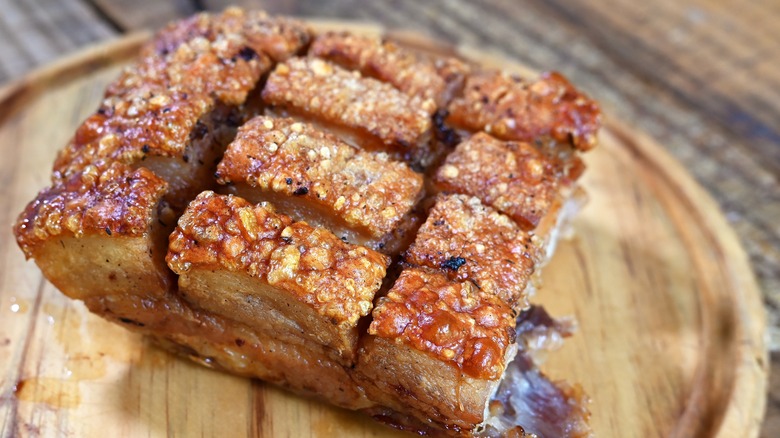2 Additions You Need For The Richest Bowl Of Pasta E Fagioli
Pasta e fagioli is winter comfort food at its best, an Italian classic that straddles the line between a thick soup and a stew. The name, which translates as pasta and beans, pretty much describes its simplicity. Although many recipes for the dish are vegetarian, some regional Italian variations may add pancetta to classic pasta e fagioli or enrich the broth with pork bones. Matthew Cutolo, a third-generation Italian-American chef at Gargiulo's Restaurant in Coney Island, Brooklyn, tells Tasting Table that there are a couple more additions that can enrich this warming soup even further.
"To add immense flavor and bring another layer of flavor to the dish, incorporate the rind of the pork," he says. Pork rind, or skin, is rich in fat and collagen and is the secret to a really great soup. Cheap parts of the pig such as neck bones, feet, and hocks are ideal for this purpose, as they come with a lot of skin still attached. Pig's feet, also known as trotters, are also very rich in collagen, which will yield a super-rich, thick broth to use as a base. "Also, use the water that you cooked the beans in when adding your liquid," Cutuolo says.
More tips for the best pasta e fagioli ever
A classic pasta e fagioli relies on a flavorful base of mirepoix — chopped onion, celery, and carrots — sauteed in olive oil. The broth is flavored with tomato paste and fresh rosemary and sage — herbs that conjure the flavors of winter. While this might sound like the start of a recipe for minestrone, there are important differences between the two classic Italian soups. The main one is the kind of beans that go in each. While a minestrone is a bit more flexible, to make pasta e fagioli, you absolutely must use white beans. Cannellini is traditional but, in a pinch, white navy beans can also do the trick.
On that note, there's another add-in that Cutuolo recommends when making pasta e fagioli to enhance the broth, which is to add the water in which you cook the beans. As they cook, the beans will release some starch into the water, which will make a more flavorful, thicker broth. In a pinch, you can add cannellini beans from a can, but your broth won't be as rich. So, here's where the pork skin in your broth comes to the rescue!
For the pasta, the small tube-shaped ditalini is traditional, but any small pasta shape that will stay whole and toothsome will be fine. For a final touch that will add extra creaminess and a hint of umami, use freshly grated pecorino or parmesan cheese, and include some of the cheese rinds in the broth to finish the soup.

